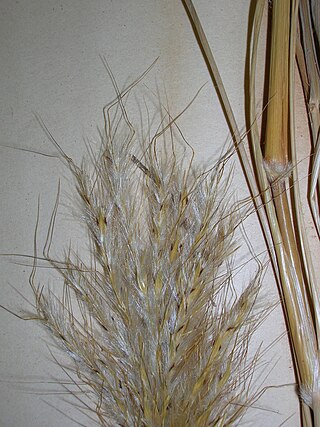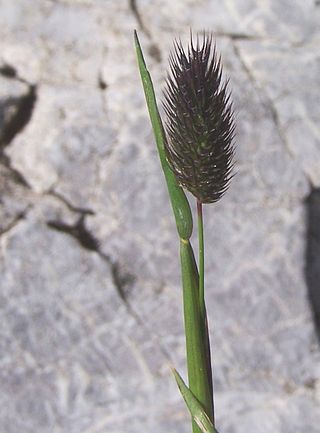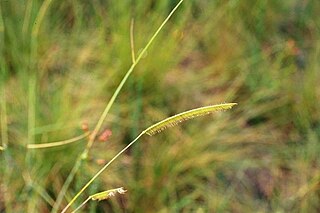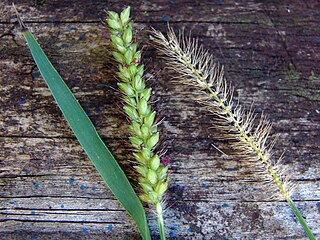
Panicum (panicgrass) is a large genus of about 450 species of Poaceae grasses native throughout the tropical regions of the world, with a few species extending into the northern temperate zone. They are often large, annual or perennial grasses, growing to 1–3 m (3–10 ft) tall.

Hainardia is a genus of coastal plants in the grass family, native to the Mediterranean Basin.

Leersia oryzoides is a species of grass known by the common name rice cutgrass or just cut-grass. It is a widespread grass native to Europe, Asia, and North America and present in many other regions, such as Australia, as an introduced species. This is a rhizomatous perennial grass growing to a maximum height between 1 and 1.5 meters. The leaves are up to about 28 centimeters long and have very rough, minutely toothed edges. The inflorescence is a loose, open array of wavy, hairlike branches bearing rows of spikelets. Each spikelet is a flat fruit with a rough, bristly lemma without an awn, and no glumes. Some of the spikelet branches develop within the sheaths of the leaves and are cleistogamous. This grass is sometimes used for erosion control and restoring wetlands.

Calamagrostis canadensis is a species of grass, having three or more varieties, in the family Poaceae. It is known variously by the common names of bluejoint, bluejoint reedgrass, marsh reedgrass, Canadian reedgrass, meadow pinegrass, Canada bluejoint and marsh pinegrass.

Bothriochloa barbinodis is a species of grass known by the common name cane bluestem. It is native to the Americas, including most of South and Central America, Mexico, and the southernmost continental United States from California to Florida.

Chloris virgata is a species of grass known by the common names feather fingergrassfeathery Rhodes-grass and feather windmill grass.

Tripsacum dactyloides, commonly called eastern gamagrass, or Fakahatchee grass, is a warm-season, sod-forming bunch grass. It is widespread in the Western Hemisphere, native from the eastern United States to northern South America. Its natural habitat is in sunny moist areas, such as along watercourses and in wet prairies. In some areas, it has adapted well to disturbed conditions.

Phleum alpinum is a species of grass known by the common names alpine cat's-tail, alpine timothy and mountain timothy.

Poa glauca is a species of grass known by the common names glaucous bluegrass, glaucous meadow-grass and white bluegrass. It has a circumboreal distribution, occurring throughout the northern regions of the Northern Hemisphere. It is also known from Patagonia. It is a common grass, occurring in Arctic and alpine climates and other areas. It can be found throughout the Canadian Arctic Archipelago in many types of habitat, including disturbed and barren areas.
Ptilagrostiella kingii is a species of grass known by the common names Sierra false needlegrass and King's ricegrass. It is the sole species in genus Ptialgrostiella. It is a perennial native to central and eastern California and to Tamaulipas in northeastern Mexico. In California it is found in the high mountains of the Sierra Nevada, where it grows in meadows and near streams in subalpine and alpine climates.
Puccinellia pumila is a species of grass known by the common names dwarf akaligrass and smooth alkali grass. It is native to North America where it grows along the coastline in the northern latitudes, from Alaska across Arctic northern Canada to Greenland. It occurs on the coast of the Pacific Northwest in the United States and it is known from the Kamchatka Peninsula. The grass is only found on the coast, in wetland habitat, beaches, and areas inundated by the highest tides, in saline sand and mud. This perennial grass grows decumbent or erect to a maximum height near 40 centimeters, often remaining much smaller, especially in harsh habitat. It may root at stem nodes which become buried in wet substrate. The inflorescence is a dense or open array of branches bearing spikelets.
Torreyochloa erecta is a species of grass in the family Poaceae known by the common name spiked false mannagrass. It is native to the Cascade Range and Sierra Nevada ranges of the western United States, its distribution extending from California north into Oregon and east into Nevada. It grows in mountain forests and the margins of lakes and streams, at elevations above 2000 meters. It is a rhizomatous perennial grass producing thick, erect stems up to about 60 centimeters in maximum height. The inflorescence is a narrow panicle much longer than wide, containing wide, compressed spikelets containing 4 to 6 florets each.

Torreyochloa pallida is a species of grass known by the common names pale false mannagrass and weak manna grass. It is native to North America, especially the east and west sides. It grows in wet habitat, such as rivers, lakesides, bogs, and swamps. It is a rhizomatous perennial grass producing thick, erect to decumbent, sometimes matted stems which can easily exceed one meter in maximum length. The inflorescence is a branching panicle up to 25 centimeters long by 12 wide containing compressed spikelets with up to 8 florets each.

Ctenium aromaticum is a species of grass known by the common name toothache grass. It is native to the southeastern United States, where it grows on the coastal plain.

Dichanthelium clandestinum is a species of grass known by the common name deertongue. It is native to eastern North America, including eastern Canada and the eastern United States.

Disakisperma dubium is a species of grass known by the common names green sprangletop and zacate gigante. It is native to the Americas, where it is distributed from the United States to Argentina.

Poa fendleriana is a species of grass known by the common name muttongrass. It is native to western North America, where its distribution extends from western Canada to northern Mexico.

Setaria parviflora is a species of grass known by the common names marsh bristlegrass, knotroot bristle-grass, bristly foxtail and yellow bristlegrass. It is native to North America, including Mexico and the United States from California to the East Coast, Central America and the West Indies, and South America.

Sporobolus spartinae is a species of grass known by the common names gulf cordgrass and sacahuista. It is native to the Americas, where it occurs from the Gulf Coast of the United States south to Argentina.

Eragrostis pilosa is a species of grass in the family Poaceae. It is native to Eurasia and Africa. It may or may not be native to North America. It is widely introduced, and it is a common weed in many areas.

















